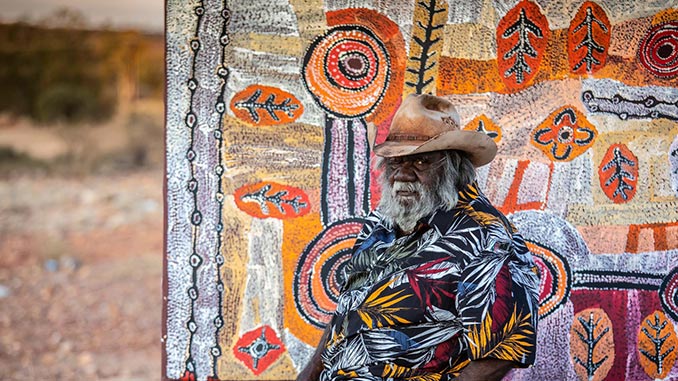 Tarnanthi, the Art Gallery of South Australia’s annual celebration of contemporary Aboriginal and Torres Strait Islander Art returns for its sixth iteration in October 2021.
Tarnanthi, the Art Gallery of South Australia’s annual celebration of contemporary Aboriginal and Torres Strait Islander Art returns for its sixth iteration in October 2021.
Internationally acclaimed as the largest festival of its kind, Tarnanthi this year comprises a major exhibition at AGSA, a state-wide festival across close to 30 partner venues and the Tarnanthi Art Fair presented over the opening weekend.
The word ‘tarnanthi’ (pronounced TAR-nan-dee) comes from the language of the Kaurna people, the traditional owners of the Adelaide Plains. It means to spring forth or appear – like the sun and the first emergence of light.
Tarnanthi presents the cutting edge of contemporary Aboriginal and Torres Strait Islander art from across the country and provides an energised platform for artists to share important stories.
Since its inception in 2015, Tarnanthi has presented the work of 4,500 First Nations artists while 1.4 million people have attended Tarnanthi exhibitions and events.
Tarnanthi 2021 will feature artists from across the continent; as far north as Cape York to the heart of the Anangu Pitjantjatjara Yankunytjatjara (APY) Lands and beyond, with works across a range of mediums – from painting, photography, printmaking, carving, sculpture, moving image, works on paper and textiles. Highlights of the Tarnanthi 2021 exhibition explore artists’ deep relationship to Country.
John Prince Siddon:
The psychedelic paintings and sculptures of Walmajarri artist John Prince Siddon will feature in the Tarnanthi exhibition at AGSA. Working from one of Australia’s most experimental art centres – Mangkaja Arts in Fitzroy Crossing, WA, Prince’s paintings deliver critical commentaries on environmental, social and political issues through his ironic combination of Australian stories, the media and ancestral creation narratives. Featuring in Tarnanthi 2021 will be a suite of paintings made on kangaroo pelts and installed on a vivid wallpaper backdrop designed by the artist.
Kathy and Tracey Ramsay:
Gija sisters Kathy Ramsay and Tracey Ramsay come from a lineage of significant artists – their grandfather Timmy Timms and their late father Rammey Ramsey are from a tiny community in Juwurlinji or Bow River. Painting on Gija Country in the East Kimberley, WA, the Ramsay sisters have created a suite of paintings predominantly using ochre for Tarnanthi.
Their paintings describe their ownership of their Country, depicting spaces that are intimately familiar to them but unknown to anyone outside Bow River. Their works become a shorthand for all of the social, cultural, political and historical knowledge that the family holds as the Traditional Owners for the Country of Bow River.
Alec Baker:
Deep knowledge and cultural memorials form the rich palette that colours Alec Baker’s bold canvases. “Sometimes I’m thinking about the colours, sometimes I’m just thinking from my memory [of] all the country I’ve been at, all the stories I have,” says the respected elder from Indulkana, in the APY Lands of South Australia.
Baker, aged almost ninety, has spent a lifetime on the land, from growing up in a traditional lifestyle on Country to his many years as a stockman. Now as the most senior artist at Iwantja Arts, the art centre he helped to found, Baker shares knowledge of Country through his painting.
His sixteen works in Tarnanthi are each called Ngura, which means Country, campsite, a place of meaning and belonging – a simple yet complex title, one that aptly expresses the essence of his long lifetime.
The Festival’s creative vision is led by Tarnanthi Artistic Director, Barkandji artist and curator, Nici Cumpston OAM. “It is an absolute privilege to bring this world-class art experience to audiences again in 2021,” she said.
“Artists presented in Tarnanthi are testament to the rich diversity of contemporary Aboriginal and Torres Strait Islander art, and we are eager to share these important stories, and this calibre of art, with our growing audiences across Australia and beyond,” said Ms Cumpston.
Premier of South Australia, the Hon. Steven Marshall MP, is delighted to see the return of the nationally celebrated Festival.
“Not only is Tarnanthi the nation’s wellspring that champions the important voices of Aboriginal and Torres Strait Islander artistic talent, Tarnanthi has also generated almost $100 million for our State’s economy,” he said.
“I am truly delighted that South Australia is home to this inspiring and influential project,” said Mr Marshall.
Tarnanthi Art Fair:
More than $4 million worth of art has been sold at the Tarnanthi Art Fair since 2015, with all money going directly to artists and communities, and all artist travel and freight costs funded by Tarnanthi. In 2021, the Tarnanthi Art Fair will be held in a new location over the opening weekend of the Festival from 15 – 17 October, at Adelaide’s Torrens Parade Ground.
International Tarnanthi exhibitions:
During 2020, when local and national exhibition programs had been seriously interrupted, Tarnanthi presented its first international offering. Kulata Tjuta, an exhibition of art from the APY Lands was presented at the Musee des Beaux-arts in Rennes, Brittany from 16 October 2020 until 3 January 2021. The exhibition lives on and is currently on view at Musées d’Art et d’Histoire in Le Havre, Normandy, France until 7 November 2021.
At its heart, the Tarnanthi Festival is a series of exhibitions, artist talks, performances and events, showcasing and celebrating contemporary Aboriginal and Torres Strait Islander art. The 2021 Gallery-wide exhibition will present works of art from studios, art centres, institutions and communities.
The full Tarnanthi 2021 program will be announced in August 2021. For more information, visit: www.agsa.sa.gov.au for details.
Image: Alec Baker, Indulkana, South Australia; image courtesy the artist and Iwantja Arts – photo by Meg Hansen
